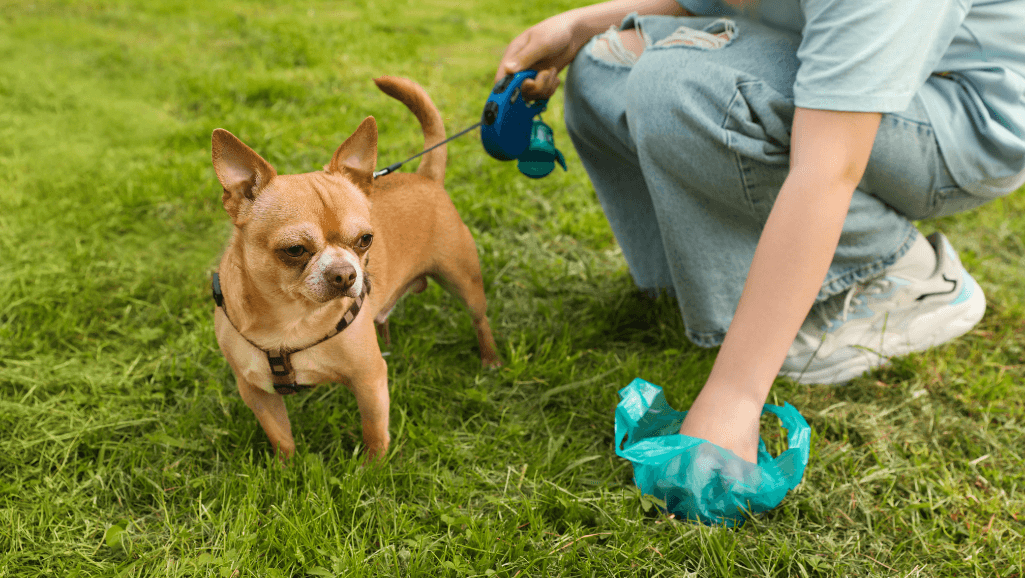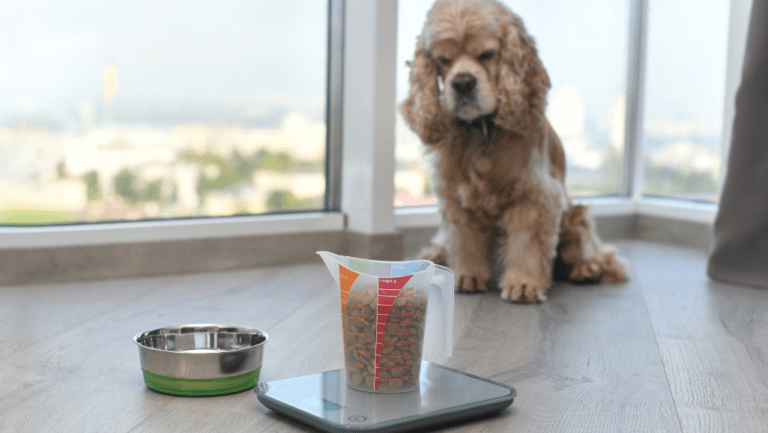As a responsible pet owner, keeping your dog’s digestive health in check is key. Regular bowel movements are vital for their well-being. But, constipation can happen. If you’re wondering how to safely help your dog poop, you’re not alone. This article will help you understand your dog’s digestive system, spot constipation signs, and find effective remedies for healthy bowel movements.
Constipation is a common issue in dogs, affecting all ages and breeds. If your dog hasn’t pooped in over 48 hours, it’s a sign of constipation. Even 24 hours can be normal for some. Diet, medication, internal blockages, or lack of exercise can cause it. Eating too much or too little fiber can also lead to constipation.
There are safe and effective ways to help your constipated dog at home. Canned pumpkin is a great remedy, providing natural fiber. For small dogs, give one tablespoon, and larger breeds can have two. But, be careful with dental chews as they can cause blockages if swallowed too fast.
Creating a daily routine with exercise and regular toilet breaks is key. If your dog has had surgery, they might need help pooping. Gentle belly rubs, exercise, and positive reinforcement can help them poop faster.
Key Takeaways
- How to Make a Dog Poop.
- Constipation in dogs is characterized by over 48 hours without defecation.
- Factors like diet, medication, blockages, and lack of exercise can cause constipation.
- Canned pumpkin is a safe and effective remedy for constipated dogs.
- Establishing a routine with daily exercise and consistent toilet breaks helps regulate bowel movements.
- If constipation persists, consult a veterinarian to rule out underlying health issues.
Understanding Your Dog’s Digestive System
A healthy digestive system is key for your dog’s health. The gut breaks down food, absorbs nutrients, and helps make vitamins. 74% of gastrointestinal diseases in dogs refer to disorders of the stomach or intestines. Watching your dog’s digestive health can prevent vomiting, diarrhea, and other problems.
Did you know each dog breed has a unique digestive system? Smaller dogs need easy-to-digest food to get the most nutrients. When picking food, think about your dog’s breed size and needs. Proteins, fibers, and fats are important for healthy stool and digestion.
Importance of Regular Bowel Movements
Regular bowel movements show your dog’s digestive health. A healthy dog should poop at least once a day. Well-formed stools mean their digestive system is working right.
But, changes in poop frequency, color, or consistency can mean health or diet issues.
Prime100 focuses on single protein and limited ingredient diets to support optimal digestive health, highlighting the role of nutrition in healthy dog poop.
Signs Your Dog Needs to Poop
Knowing when your dog needs to poop is important. Look for signs like:
- Restlessness and pacing
- Sniffing the ground intently
- Circling a specific area
- Squatting or assuming a hunched posture
Understanding your dog’s digestive system and watching their bathroom habits helps keep them healthy. Regular exercise, a balanced diet, and a calm environment are all key for good digestion and overall health.
Factors Influencing Your Dog’s Bathroom Habits
Many things can change how your dog poops, like what they eat, how much they exercise, and how stressed they are. Knowing these can help solve dog poop issues. You might even think about training them to use a litter box.
Diet and Its Impact on Digestion
What your dog eats is key to their digestive health and how often they poop. A balanced diet with enough fiber helps them go regularly. Adult dogs usually poop once a day, but puppies might go up to five times.
It takes 8-12 hours for most dogs to digest food, with puppies doing it faster than older dogs.
Exercise and Bowel Regularity
Exercise is vital for your dog’s health and affects their pooping. Making sure they get enough physical activity helps them poop regularly. It’s good to walk your dog twice a day, 30 minutes after meals, to help with bowel movements.
“Dogs thrive on routine, and having a regular schedule for meals, walks, and bathroom breaks can significantly impact their pooping habits.”
Stress and Anxiety Considerations
Stress and anxiety can mess with your dog’s bathroom habits. Changes like moving or getting a new pet can cause irregular pooping. A calm, comfy spot for them to poop can help with stress-related digestive problems.
By understanding these factors and making changes, you can help your dog poop regularly. This can reduce dog poop problems and even lead to using a litter box.
Establishing a Routine for Your Dog
Creating a consistent routine is key for dog potty training. Dogs love routine and it helps them adjust to new places. Regular feeding times and a potty schedule help control their bowel movements.
Dogs need to go potty every few hours, based on their age and breed. Puppies and older dogs might need more breaks. Adding potty breaks to your daily plan helps prevent accidents at home.
Setting Regular Feeding Times
Feeding your dog at the same times each day helps their digestive system. Most medium-sized dogs poop 1-3 times a day. This makes it easier to plan when they’ll need to go potty.
Creating a Potty Schedule
Consistency is vital for dog potty training. Pick a potty spot and take your dog there at set times. Use treats and praise to encourage them to go in the right place. Accidents happen, so be patient. Some dogs might take weeks to learn.
“Positive reinforcement is the cornerstone of effective dog training.” – DoodyCalls
If potty training is tough, consider professional help. Services like DoodyCalls offer poop pick-up and can give you a free quote by calling (888) 659-6558.
Dietary Adjustments to Promote Pooping
Diet is key to healthy bowel movements in dogs. Simple food changes can greatly improve their digestive health. Let’s look at some dietary strategies to help your dog stay regular.
High-Fiber Foods for Dogs
Adding high-fiber foods to your dog’s diet helps a lot. Fiber makes stool bulkier, making it easier to pass. Good fiber sources include:
- Pumpkin: Canned pumpkin (not pumpkin pie filling) is a natural source of fiber that can help regulate digestion.
- Bran: Wheat bran or oat bran can be added to your dog’s food to increase fiber intake.
- Vegetables: Carrots, green beans, and sweet potatoes are fiber-rich vegetables that can be incorporated into your dog’s meals.
Start with small amounts of high-fiber foods to help your dog’s digestive system adjust. Talk to your vet to find the right amount for your dog.
Hydration and Its Role
Keeping your dog hydrated is vital for their digestive health. Water softens stool and aids digestion. Make sure your dog always has fresh, clean water. Place water bowls around the house and keep them full.
If your dog doesn’t like water, try adding low-sodium chicken broth or unsalted beef broth. Also, moist or canned food can help increase water intake.
Supplements for Digestive Health
Your vet might suggest digestive health supplements for your dog. These can include:
- Probiotics: These beneficial bacteria help maintain a healthy gut flora, aiding in digestion and promoting regular bowel movements.
- Digestive Enzymes: Supplements containing digestive enzymes can help break down food more efficiently, easing the digestive process.
- Omega-3 Fatty Acids: These essential fatty acids have anti-inflammatory properties that can support overall gut health.
“A balanced diet rich in fiber, combined with proper hydration and targeted supplements, can work wonders for your dog’s digestive health and promote regular bowel movements.”
Always talk to your vet before adding new supplements to your dog’s diet. This ensures they’re right for your pet.
Utilizing Physical Activity
Regular physical activity is key for a dog’s health and well-being. It also helps with digestion and bowel movements. Daily exercise can stimulate their digestive system, lowering the risk of constipation and other issues.
Daily Walks and Their Benefits
Daily walks are a simple yet effective way to add exercise to your dog’s routine. Experts say regular walks help food move through the digestive tract, cutting down on constipation. The walks also boost blood circulation and encourage regular bowel movements.
Walks also offer mental stimulation and let your dog explore. This can reduce stress and anxiety, which can harm a dog’s digestion.
Engaging Playtime Activities
Playtime activities, like fetch and hide-and-seek, are great for digestion too. They provide physical exercise and strengthen your bond with your dog.
Choose play activities that fit your dog’s age, breed, and energy level. For older dogs or those with mobility issues, consider swimming or short walks.
“Regular exercise is beneficial as it helps move food along the digestive tract efficiently, reducing the chances of constipation.” – Pet Health Expert
By adding daily walks and playtime to your dog’s routine, you can improve digestion and prevent constipation. Remember, a lack of exercise can lead to digestive problems. So, make sure to prioritize your dog’s physical activity needs.
The Importance of a Stress-Free Environment
A dog’s digestive health can be greatly affected by stress and anxiety. Chronic stress can upset the balance of gut bacteria. This can lead to problems like dog stress diarrhea or constipation.
To help your dog’s digestive health, it’s key to create a calm environment. You need to know what stresses your dog and reduce those stressors.
Recognizing Stress Triggers
Many things can cause dog anxiety and stress, including:
- Loud noises (e.g., thunderstorms, fireworks)
- Changes in routine or environment
- Separation from family members
- Unfamiliar people or animals
- Lack of exercise or mental stimulation
“Stress is one of the most under-recognized contributing factors to gastrointestinal disorders in dogs.” – Dr. Lisa Lippman, DVM
Knowing what stresses your dog helps you take steps to reduce it. This makes your home a more peaceful place.
Creating a Comfortable Potty Area
Reducing stress and having a comfy potty area helps with regular bowel movements. Here are some tips:
- Choose a quiet, secluded spot in your yard
- Ensure the area is easily accessible and free from obstacles
- Provide a comfortable surface, such as grass or pea gravel
- Keep the area clean and free from waste
- Offer plenty of praise and rewards when your dog uses the designated spot
A safe and inviting potty area helps reduce dog anxiety. It also encourages healthy bathroom habits.
Recognizing Constipation in Dogs
As a responsible pet owner, knowing the signs of constipation in your dog is important. Constipation can cause discomfort and health problems if not treated. Recognizing these signs early helps you take action to ease your dog’s discomfort.
Symptoms and Signs of Constipation
Constipated dogs may show these symptoms:
- Straining to defecate
- Producing small, hard stools
- Not pooping for several days
- Loss of appetite
- Lethargy and discomfort
Veterinary books say the main cause of constipation in dogs is eating things they shouldn’t. Lack of exercise, dehydration, diet problems, and some medicines also play a role. Older dogs are more likely to get constipated because of changes in their digestive system.
Dogs should poop at least once a day. If they haven’t in 48 to 72 hours, they might be constipated. In such cases, adding pumpkin puree or fiber supplements to their diet can help.
When to Consult a Veterinarian
While mild constipation can be managed at home, sometimes you need a vet. If your dog’s constipation doesn’t get better with home remedies or if they’re in a lot of pain, see a vet quickly.
“Constant vigilance and understanding a dog’s symptoms, changes in diet, medication, and other factors are essential when dealing with constipation in canines.”
Your vet will do a detailed check-up. This might include feeling your dog’s belly, a rectal exam, X-rays, or other tests to find out why they’re constipated. Based on what they find, they’ll suggest the best treatment, which could be diet changes, medicines, or surgery in serious cases.
Remember, early recognition and prompt action are key to managing constipation in dogs effectively. By watching your dog’s bathroom habits and seeing a vet when needed, you can keep them healthy and happy.
Home Remedies to Stimulate Bowel Movements
When your dog is constipated, you might look for natural ways to help before seeing a vet. It’s key to talk to a vet if your dog’s constipation lasts more than 48 hours or if they’re in pain. But, some home remedies can help with mild cases.
Natural Laxatives for Dogs
Adding natural laxatives to your dog’s food can ease constipation. Pumpkin puree is a good choice, as it’s high in fiber. It can make stool softer and help with digestion, according to the Merck Veterinary Manual.
Other safe options include bran and psyllium husk. These are fiber-rich and can help keep your dog’s digestive system healthy. But, always check with your vet before changing your dog’s diet, if they have health issues.
Safe Oils for Digestive Aid
Adding a bit of oil to your dog’s food can make digestion easier. Olive oil and coconut oil are safe choices. They help with digestion and can also improve your dog’s skin and coat.
Start with a small amount of oil and slowly increase it. A good rule is 1 teaspoon of oil per 10 pounds of body weight. But, your vet can give you the best advice for your dog’s specific needs.
Regular exercise can promote normal movement within the gastrointestinal tract and aid in relieving constipation in dogs.
Keeping your dog hydrated and active can also help with constipation. A healthy weight is important for their overall health and digestion. A balanced diet and regular exercise are key.
Veterinary Options for Stubborn Cases
If your dog’s constipation doesn’t get better with home remedies, it’s time to see a vet. Chronic constipation can mean there’s a bigger health issue, like an obstruction. If your dog shows signs of illness or constipation for over a day, call your vet.
Common Medical Treatments
Vets have many ways to help dogs with stubborn constipation. They might give enemas to make stool softer and easier to pass. For severe cases, they might need to remove impacted feces under anesthesia.
They can also give medications like stool softeners or laxatives. These help keep bowel movements regular and reduce discomfort.
Diagnostic Procedures
Vets use tests to find out why your dog is constipated. X-rays and ultrasounds help them see inside your dog’s digestive tract. They look for blockages or other problems.
Blood tests and fecal analyses also help. They check your dog’s overall health and look for infections or parasites. This way, vets can create a treatment plan that really works.
“Veterinary care is essential for managing severe or persistent constipation in dogs. Through a combination of medical treatments and diagnostic procedures, veterinarians can help alleviate your furry friend’s discomfort and promote optimal digestive health.”
Always be careful about your dog’s health. If home remedies and diet changes don’t work, see a vet. Your vet is there to help your dog’s digestive system work right. This way, your dog can stay happy and healthy with you.
Monitoring Your Dog’s Health
As a responsible pet owner, it’s important to watch your dog’s health closely. Paying attention to their bowel movements is a good way to do this. It helps you see if they have any digestive problems that need vet care.
Keeping a Poop Journal
Keeping a poop journal is a great idea. It helps you track your dog’s bowel movements. You can note the frequency, consistency, color, and any odd features of their stool. This way, you can spot any changes that might mean they’re not feeling well.
Also, a poop journal is useful when talking to your vet. It gives them a clear picture of your dog’s digestive health.
What Constitutes Normal vs. Abnormal
Knowing what’s normal and abnormal in dog poop is key for dog health monitoring. Healthy poop is firm, segmented, and easy to pick up. It’s usually brown, depending on what your dog eats. Vets rate poop on a scale of 1-7, with a 2 being the best.
Abnormal poop, on the other hand, can show up in many ways. Look out for:
- Diarrhea or watery stools
- Mucus or blood in the stool
- Excessive straining during bowel movements
- Unusual colors such as yellow, orange, green, red, black, or grey
- Presence of undigested food, hair, or foreign objects
- Slimy coating or excessive odor
If abnormal stool lasts more than 24 hours, or if your dog shows other symptoms, see your vet.
By watching your dog’s poop closely, you can help keep their digestive system healthy. Knowing what’s normal and abnormal can help you catch problems early. This can really help your dog feel better.
Conclusion
Promoting dog digestive health is key for their well-being. A balanced diet, regular exercise, and a calm environment are essential. Madson, C. (2024) stresses the need for a regular bathroom routine for dogs’ health and happiness.
Adding fiber-rich foods like plain, canned pumpkin (Emeh, J. & Rose-Francis, K., 2023) or coconut oil (Dos Anjos, M., 2023) can help. But, too much fiber can make digestion harder (Burrows, C., Kronfeld, D., Banta, C., & Merritt, A., 1982). Also, make sure your dog drinks enough water and avoids foods that can cause constipation.
Regular exercise is important for bowel regularity, but too much can harm the intestines (Davis, M., Willard, M., Williamson, K., Steiner, J., & Williams, D., 2005). Aim for moderate, consistent exercise and keep your dog’s environment stress-free. By watching your dog’s health and seeking vet care when needed, you can ensure they stay healthy and happy.
Summary of Best Practices
To recap, the best practices for promoting dog digestive health and regular bowel movements include:
- Providing a balanced diet with appropriate fiber content
- Encouraging regular, moderate exercise
- Ensuring adequate hydration
- Establishing a consistent feeding and potty schedule
- Reducing stress and creating a comfortable environment
- Monitoring your dog’s health and keeping a poop journal
- Seeking veterinary care when needed
Encouraging Healthy Habits for Dogs
By following these best practices, you can help your dog develop healthy habits. Remember, every dog is different, so it might take some time to find what works best. With patience, consistency, and a focus on your dog’s well-being, you can help them stay healthy and enjoy life with you.





















